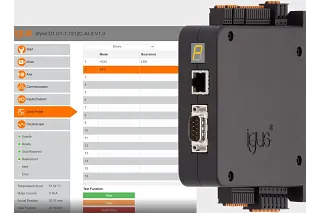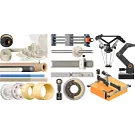Change Language :
Motor controller
The innovative motor control systems for stepper EC/BLDC and DC motors
With drylin® motor controller systems, igus® offers cost-effective and easy-to-use solutions for controlling linear and rotary drives.
Commissioning is quick and easy. The motor controllers can be adjusted directly at the device or conveniently via web server and laptop, tablet or smartphone. To reduce commissioning times and related costs, there are free sample programmes to go with the motor controllers.
Motor controller types
White paper and sample programs
What is a motor control system and how do I know which one I need?

Our motor controllers are essential for precise and reliable automation. Designed to operate electric motors via integrated switchboards, they enable controlled movement across a wide range of applications.
We offer solutions compatible with various motor types, including:
- Stepper motors
- DC motors
- Direct current motors
These systems allow you to predefine travel paths, positions, speeds, and operating times. Whether you're using a stepper motor like the D1 with a web-based interface or a D3 DC motor system, our controls make managing linear systems simple and intuitive.
Key Features:
- Easy integration with industrial control systems
- User-friendly interfaces
- Free sample programs included for testing and development
Frequently asked questions about motor control systems
A motor control system is an electronic device that operates the motor for the movement within applications. igus® has a range of motor controllers, which are suitable for all sorts of motors and applications.
The D1 motor controller can be used to control DC, EC and stepper motors. All of these motors can be bought in the shop, alongside the motor controllers
The D3 controllers can control DC motors.
The method depends on the type of motor you're using. Here are the most common ways:
- DC Motors: Speed is controlled by adjusting the voltage. Lower voltage means slower speed.
- PWM (Pulse Width Modulation): Used for DC and brushless motors. It rapidly switches power on and off to vary the average voltage, offering precise and efficient speed control.
- AC Motors: Speed is managed using a Variable Frequency Drive (VFD), which changes the frequency and voltage of the power supply.
- Stepper Motors: Speed is controlled by changing the rate of step pulses sent to the motor driver.
- Mechanical Gear Reduction: Gearboxes can reduce speed and increase torque without electronic control.
- Closed-Loop Systems: Sensors like encoders provide feedback to adjust motor speed dynamically, ideal for precision applications.
A motor controller regulates the operation of an electric motor by managing its speed, direction, torque, and start/stop functions. It acts as an interface between the motor and the control system.
Key functions include:
- Power regulation: Controls the voltage or current supplied to the motor.
- Speed control: Adjusts motor speed using methods like voltage variation, PWM (Pulse Width Modulation), or frequency control (for AC motors).
- Direction control: Reverses motor rotation by switching polarity or phase.
- Protection: Prevents damage from overloads, overheating, or short circuits.
- Feedback integration: Uses sensors (e.g., encoders) to monitor performance and adjust output in real time.
Motor controllers can be manual, digital, or software-based, and are commonly used in automation, robotics, and industrial machinery.
Yes we absolutely do. You can:
- Download programs with master/control system program & dryve parameterisation
- Reduced integration time
- Cost savings
- Compatible with industrial manufacturers (Siemens, Beckhoff, Wago etc.)
- Compatible with conventional single-board computers/developer boards
(Arduino, Raspberry Pi, Beaglebone)
Consulting
I look forward to answering your questions

Shipping and consultation
In person:
Monday to Friday from 8 am - 5 pm.







